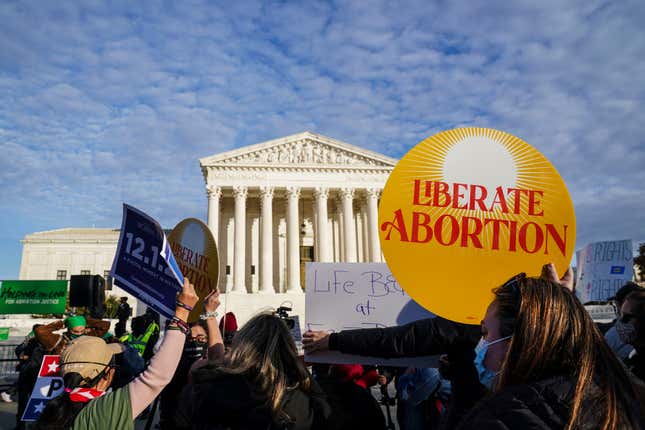Congress Failed to Protect Abortion. Now the Fight Turns Local.
As the Supreme Court prepares to gut Roe v. Wade, it's time to look past the federal government for help.
AbortionPolitics

In a historic move last week, the Senate finally scheduled a vote for the Women’s Health Protection Act (WHPA), a bill Democrats have been trying to pass for a decade that would codify Roe v. Wade into federal law and enshrine federal protections for abortion rights. Then, of course, Senate Republicans and their Democratic buddy, noted Grim Reaper of political progress Joe Manchin, blocked the legislation.
If you care even vaguely about the very basic human right to not be forced by the state to give birth, I’d wager you’re probably pretty frustrated right now: States are practically racing each other to pass the worst possible abortion bans, the Supreme Court is all but guaranteed to overturn Roe in its upcoming decision on Dobbs v. Jackson Women’s Health, and we’re watching in real-time as the Democratic-controlled federal government does absolutely nothing about it.
But there’s still cause for hope—and certainly for action—in the absence of federal help. On the state, local, and community levels, the vital protections and supports baked into WHPA are already here. In January, New Jersey became the first state to codify abortion rights into state law in 2022, joining 14 other states and DC with similar, proactive protections. Just last month, Vermont lawmakers passed a first-of-its-kind constitutional amendment to guarantee the right to abortion and contraception, pending approval from Vermont voters later this year.
California has even taken it upon itself to become an “abortion sanctuary” as bans like Texas’ spread like a rash across the country, forcing exponentially rising numbers of people to travel out-of-state just to access a basic health service. To meet the needs of more and more out-of-state patients, Gov. Gavin Newsom (D) last year launched the California Future of Abortion Council, comprising reproductive health providers, advocates, and researchers across the state who are working together to offer goals and recommendations to expand abortion access. The council’s early recommendations have included increasing the rate that Medi-Cal, the state’s health care system, pays for abortions, which could lead to more health providers in California being able to offer lower-cost abortion services. Last week, the state’s legislature introduced a bill that would allow nurse practitioners to provide abortions without the supervision of a physician. This would substantially increase the amount of abortion providers in the state, while also destigmatizing the health procedure by recognizing its safety and simplicity.
Threats to Roe, and bans like Texas’, which is enforced by incentivizing citizens to spy on each other and sue abortion providers, also mean increased risk of criminalization. Criminal charges for miscarriages, stillbirths, and self-managed abortions via medication—which can’t be distinguished from a miscarriage—have notably tripled in recent years, subjecting nearly all pregnant bodies, and particularly those of people of color, to criminal suspicion. States like California provide a blueprint for other states on this front as well.
In January, California Attorney General Rob Bonta issued a statewide alert advising law enforcement to not charge people for murder over pregnancy loss, regardless of their behavior—including drug use—before losing the pregnancy. Notably, 38 states maintain feticide laws like this, which would ideally serve to protect pregnant people considering homicide is a leading cause of death for them—instead, these laws have often been used by prosecutors to punish pregnant people.
The potential for radical, life-affirming progress toward reproductive justice is even more expansive on the local level. While the Hyde Amendment prohibits federal funding for most abortions, city councils in Austin, Texas; Portland, Oregon; and New York City have all established public funds to support abortion access, and there’s growing public pressure for Los Angeles County to do the same. The organizing work of local abortion funds was vital to the creation of these public funds.
Ultimately, no one’s ability to get abortion care without barriers should be contingent on their ZIP code. But in the face of constant political attacks on reproductive rights and the health and autonomy of pregnant people, advocates and community members have always found ways to get people the care they need and deserve.
A new study shows most Texans impacted by their state’s abortion ban have still been able to get care some other way, primarily by traveling out-of-state or seeking abortion pills. This—like swift action from states and city councils to expand abortion access—is a testament to the resiliency of local organizers, and certainly, the power of abortion funds, of community members taking care of each other when the federal government neglects to do so. The work to protect abortion access is already being done, all around us—instead of despairing federal failures, we can take action in our own communities.